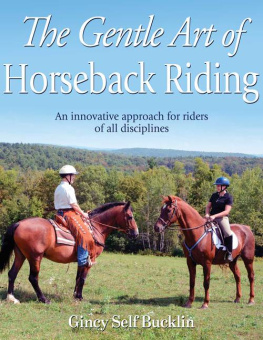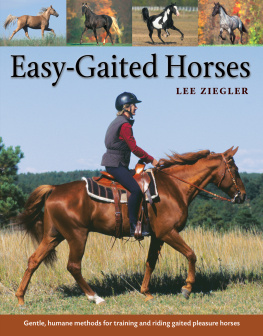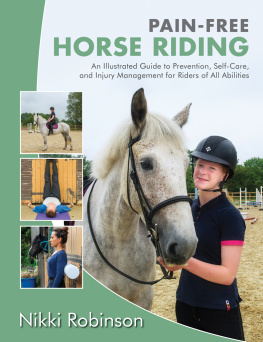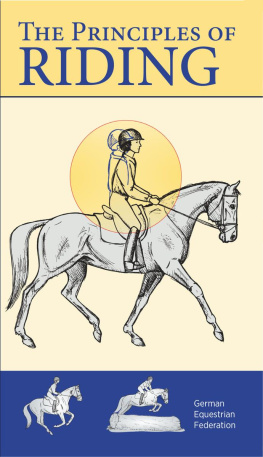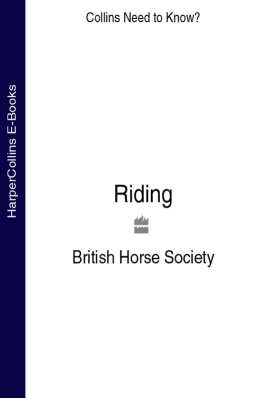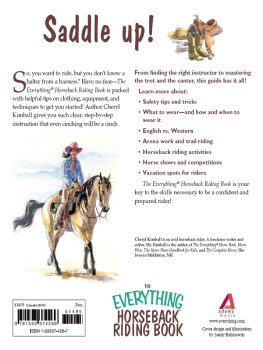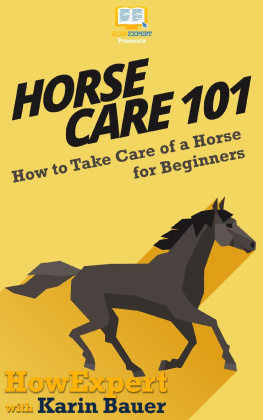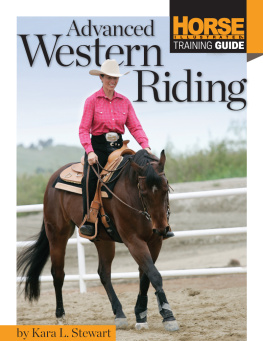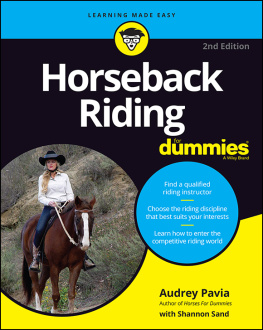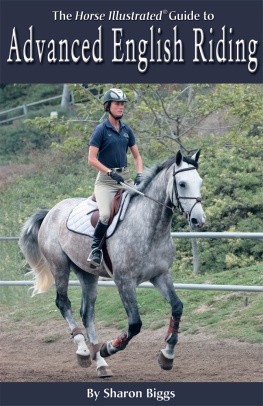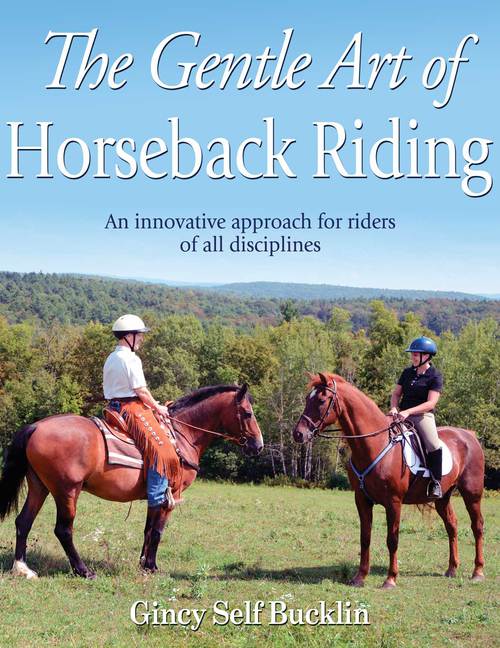
The Gentle Art of Horseback Riding
Gincy Self Bucklin

Human Kinetics
Library of Congress Cataloging-in-Publication Data
Bucklin, Gincy Self.
The gentle art of horseback riding / Gincy Self Bucklin.
pages cm
Includes index.
1. Horsemanship. I. Title.
SF309.B883 2013
798.2--dc23
2012046054
ISBN-10: 1-4504-1274-2 (print)
ISBN-13: 978-1-4504-1274-2 (print)
Copyright 2013 by Virginia S. Bunker
All rights reserved. Except for use in a review, the reproduction or utilization of this work in any form or by any electronic, mechanical, or other means, now known or hereafter invented, including xerography, photocopying, and recording, and in any information storage and retrieval system, is forbidden without the written permission of the publisher.
This publication is written and published to provide accurate and authoritative information relevant to the subject matter presented. It is published and sold with the understanding that the author and publisher are not engaged in rendering legal, medical, or other professional services by reason of their authorship or publication of this work. If medical or other expert assistance is required, the services of a competent professional person should be sought.
The web addresses cited in this text were current as of January 2013, unless otherwise noted.
Acquisitions Editor: Tom Heine
Developmental Editor: Carla Zych
Assistant Editor: Claire Marty
Copyeditor: Jan Feeney
Indexer: Nan N. Badgett
Graphic Designer: Nancy Rasmus
Graphic Artist: Francine Hamerski
Cover Designer: Keith Blomberg
Photographs (cover and interior): Neil Bernstein
Visual Production Assistant: Joyce Brumfield
Photo Production Manager: Jason Allen
Art Manager: Kelly Hendren
Associate Art Manager: Alan L. Wilborn
Illustrations: Human Kinetics
Printer: Versa Press
We thank Caryl Richardson of Stone Gate Stables in Putney, Vermont, for assistance in providing the location for the photo shoot for this book.
Human Kinetics books are available at special discounts for bulk purchase. Special editions or book excerpts can also be created to specification. For details, contact the Special Sales Manager at Human Kinetics.
Printed in the United States of America
10 9 8 7 6 5 4 3 2 1
The paper in this book is certified under a sustainable forestry program.
Human Kinetics
Website: www.HumanKinetics.com
United States: Human Kinetics
P.O. Box 5076
Champaign, IL 61825-5076
800-747-4457
e-mail: humank@hkusa.com
Canada: Human Kinetics
475 Devonshire Road Unit 100
Windsor, ON N8Y 2L5
800-465-7301 (in Canada only)
e-mail: info@hkcanada.com
Europe: Human Kinetics
107 Bradford Road
Stanningley
Leeds LS28 6AT, United Kingdom
+44 (0) 113 255 5665
e-mail: hk@hkeurope.com
Australia: Human Kinetics
57A Price Avenue
Lower Mitcham, South Australia 5062
08 8372 0999
e-mail: info@hkaustralia.com
New Zealand: Human Kinetics
P.O. Box 80
Torrens Park, South Australia 5062
0800 222 062
e-mail: info@hknewzealand.com
E5498
Several years ago my daughter Karen asked me what my lifes goal was. Without really thinking about it, I answered, To change the way riding is taught at the novice level. She said, Id like to help you. And so, with her help, the non-profit organization What Your Horse Wants was born. Whether I will attain my goal in my lifetime remains to be seen, but whatever work toward that end is accomplished through this book owes much to her help and support. And so I dedicate this book to my wonderful daughter, Karen Stoddard Hayes.
Contents
Preface
Riding is a sport that differs in many ways from most other sports, both in our understanding of it and in how it is performed.
To begin with, riding is not one sport, but many, each with its own levels of competition. For example the two major disciplines in the United States, English and Western, are further subdivided into many categories. Dressage, hunter, and saddle seat are English categories; reining, cutting, and barrel racing are Western. The enormous field of pleasure riding, with all its variations, rounds out the myriad activities that fall under the general term riding. Almost unique in the sport world, in nearly all disciplines women compete on an equal basis with men, and age is not a factor. In fact, being older can be an advantage.
The most important way in which riding differs from other sports is rarely considered. If you take up kayaking and paddle so badly that you drift all over, the kayak doesnt care. If you play golf badly, slicing the ball into the water hazard, it doesnt hurt the ball. But if you ride even a little bit badly, you make the horse uncomfortable. If you ride very badly, you damage the horse both emotionally and physically, often for life.
Although horses, taken separately, are every bit as individual as humans, they all share certain characteristics. By understanding the horse and how to relate to him physically, mentally, and emotionally, you will find that learning the fundamentals of riding can be relatively simple, confidence inspiring, and fun.
On the assumption that you care about horses, the goal of this book is to help you to ride well, not just after years of training, but right from the start. Or if you have been riding and are not satisfied with your skills, this book will help you to improve as quickly as possible. Instructors, especially of novice riders, will find that following this method not only is horse friendly but also produces a good rider in the shortest possible time. (This does not mean 6 months, but less than 5 years, as opposed to the 25 years that tradition says is the time needed.)
Before we go on, we need a definition of a good rider, one who is riding correctly. It simply means that the rider can ride in a way that is comfortable for both rider and horse and do all the basic movementswalk, trot, canter, and make turns and transitionsplus anything that both have been trained to do, without difficulty or resistance by the horse. In current mainstream riding of any discipline, the first few lessons for a novice student go something like this: She is introduced to the horse in the somewhat threatening confinement of the stall, then to grooming, tacking, and leading. Next she is mounted in the saddle and given stirrups and reins. She is shown how to ask the horse to go, stop, and turn and often how to trot and post. Occasionally she is put on the longe (the horse is on a long line held by the instructor, around whom he circles) so that she does not have to try to control the horse. But often, especially in camps and similar programs, several beginners are turned loose together to struggle with all this new information.
Attempting to take in such a tremendous amount of material in a short period is a bit like learning your numbers and how to add and subtract, all in the same one-hour lesson. Add in the psychological aspect of working with an extremely large and strange animal, which you are expected to control, and on whom you are trapped like a cat in a tree, 6 or 7 feet above the ground. It speaks volumes for the kindness of horses that so many people, after this sort of experience, continue to ride.
Next page
